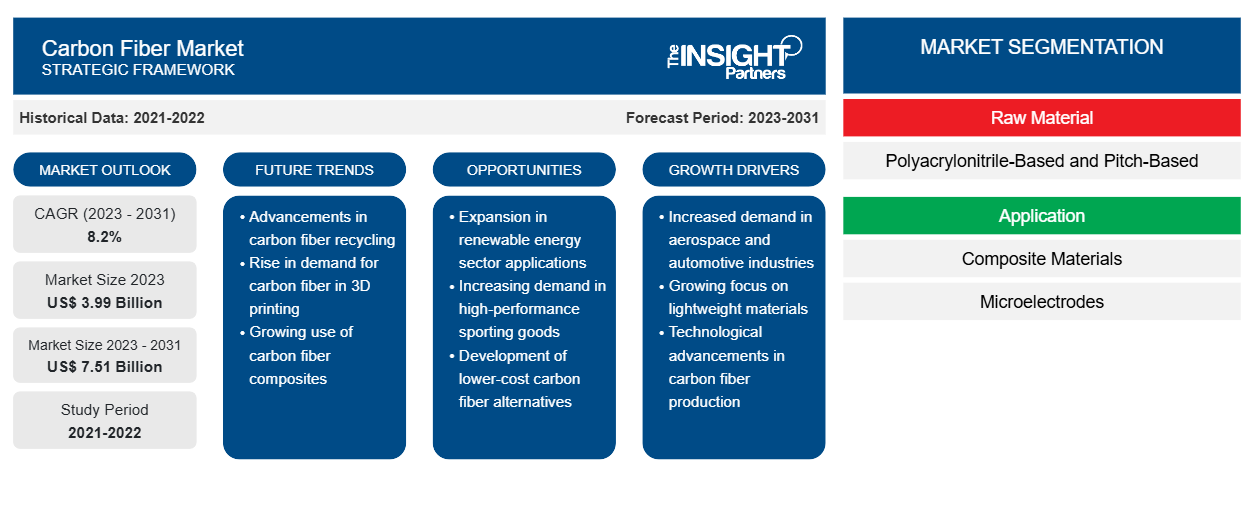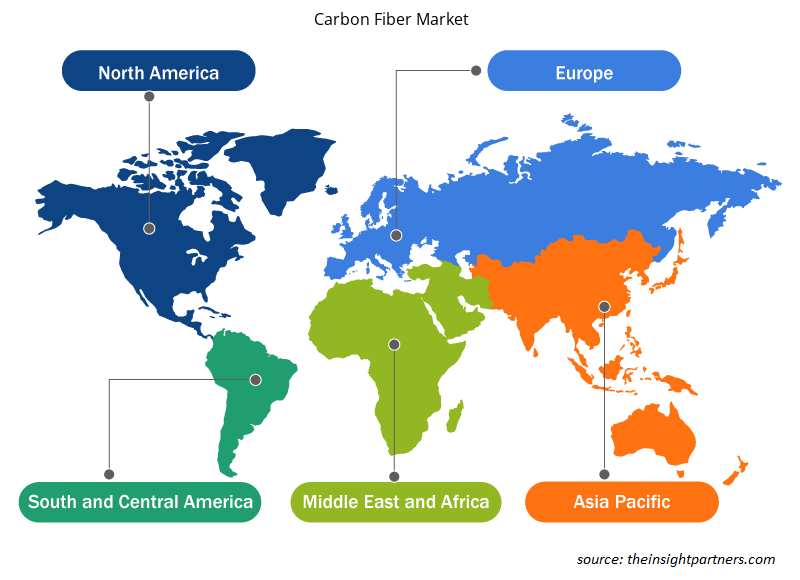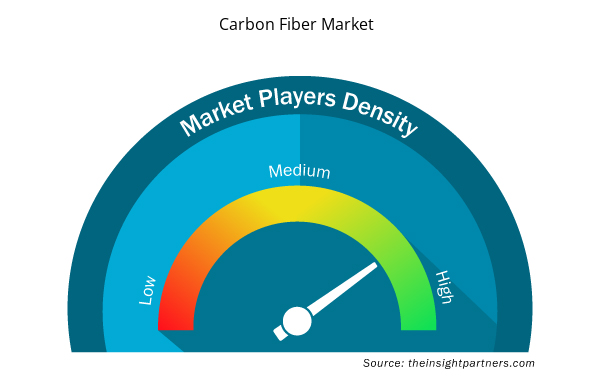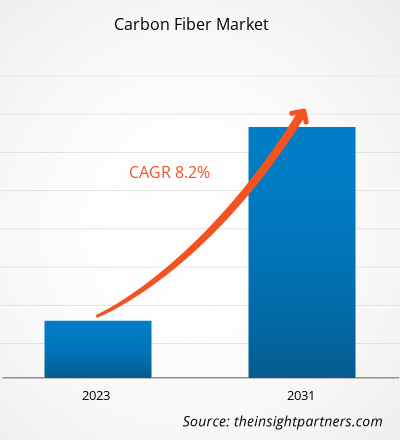The carbon fiber market size is projected to reach US$ 7.51 billion by 2031 from US$ 3.99 billion in 2023. The market is expected to register a CAGR of 8.2% during 2023–2031. The rising demand from aerospace, automotive, sports equipment, and industrial sectors is likely to bring new carbon fiber market trends in the future.
Carbon Fiber Market Analysis
Carbon fiber possesses remarkable mechanical strength, stiffness, and heat and chemical resistance. They are significantly lighter than steel or aluminum but exhibit relative or superior strength. This makes carbon fiber sought-after material in applications where weight reduction is crucial such as aerospace, automotive, sports equipment, and industrial sectors. The carbon fiber market is expected to continue to grow as industries across various sectors increasingly adopt carbon fiber composites to meet their need for lightweight, durable, and energy-efficient materials. Technological advancements in carbon fiber manufacturing processes and the development of cost-effective production techniques are also likely to contribute to the market expansion in the coming years.
Carbon Fiber Market Overview
Automotive manufacturers seek innovative and high-quality materials for the production of lightweight automotive components that have high mechanical and tensile strength. Carbon fiber is considered as one of the most suitable materials for lightweight automobile part production. Moreover, the carbon-fiber-reinforced composites are used as the essential material to substitute steel and aluminum parts that are heavier in weight and result in reduced fuel efficiency. The use of carbon fiber in the automobile industry has improved fuel efficiency, leading to energy conservation and minimizing carbon dioxide emissions. Leading automotive manufacturers are using carbon fiber for manufacturing components. For instance, a Airbus A350 unit consists of 52% carbon fiber-reinforced polymer (CFRP), whereas a BMW i3 unit has mostly CFRP chassis.
Customize This Report To Suit Your Requirement
You will get customization on any report - free of charge - including parts of this report, or country-level analysis, Excel Data pack, as well as avail great offers and discounts for start-ups & universities
Carbon Fiber Market: Strategic Insights

- Get Top Key Market Trends of this report.This FREE sample will include data analysis, ranging from market trends to estimates and forecasts.
Customize This Report To Suit Your Requirement
You will get customization on any report - free of charge - including parts of this report, or country-level analysis, Excel Data pack, as well as avail great offers and discounts for start-ups & universities
Carbon Fiber Market: Strategic Insights

- Get Top Key Market Trends of this report.This FREE sample will include data analysis, ranging from market trends to estimates and forecasts.
Carbon Fiber Market Drivers and Opportunities
Adoption of Lightweight Turbine Blades in Wind Energy Industry Bolsters Carbon Fiber Market Growth
There has been a notable surge in the installation of wind farms with the growing preference to utilize renewable resources. Large tracts of land and coastal areas in different countries are allocated for wind turbine operations. Carbon fibers play an important role in the wind energy industry. Wind turbine manufacturers, nowadays, produce more efficient longer and lightweight blades using advanced composite materials such as carbon fibers. Extending the length of turbine blades enables greater energy generation. Large blades are typically designed with a key focus on stiffness and tip deflection. Nonetheless, the high stiffness of carbon fiber contributes to lower blade deflection. Thus, large turbine blades made from composite carbon fibers allow a larger tower diameter for a given blade-to-tower clearance. Carbon fiber is also used in the spar cap, which is the backbone of the blade.
Carbon fibers are proven to be an effective alternative to glass fibers in wind turbine designs due to their higher stiffness and lower density compared to glass fibers, thus, allowing the thinner, stiffer and lighter blades. However, blades made of carbon fiber exhibit relatively low damage tolerance, compressive strength, and ultimate strain. Therefore, carbon fibers are most commonly used in the fabrication of wind turbine blades. Companies such as Vestas Wind Systems A/S and Gamesa Technology Corp use carbon fiber in selective structural parts of blades and take the advantage of the lighter weight blades throughout the turbine system. Light blades require less robust turbine and tower components, eventually resulting in the reduction of overall costs. Thus, an upsurge in the use of lightweight turbine blades in the wind energy industry bolsters the demand for carbon fiber, thereby bolstering the market growth.
Rising Demand for Carbon Fiber in 3D Printing to Generate Growth Opportunities
In the recent years, 3D printers have gathered attention as a multi-product small-volume production technology. 3D printing carbon fiber is the most popular additive manufacturing technology. Carbon fiber-reinforced plastics are added to the 3D printing filaments to improve the elasticity and strength of the printed parts. These composite materials have much higher strength than metals, irrespective of their lower weight than metals. Additionally, carbon fibers can be mixed with plastic resins to fortify the mechanical properties of 3D printed parts. 3D printing using carbon fiber-reinforced composites is among the most sought-after additive manufacturing technologies. Additive manufacturing technology is gaining immense traction due to its advantages such as potential cost reductions, higher part complexity, functional integration. Carbon fibers are used to develop 3D printing materials for racing cars, construction materials, sports equipment, drones, daily-use products, etc. Some major businesses are focused on launching carbon fiber-based 3D-printed composites.
Carbon Fiber Market Report Segmentation Analysis
Key segments considered to present the carbon fiber market analysis are product and end use.
- Based on raw material, the carbon fiber market is segmented into polyacrylonitrile-based and pitch-based. The polyacrylonitrile-based segment held a larger market share in 2023.
- By application, the carbon fiber market is segmented into composite materials, microelectrodes, and others. The composite materials segment held the largest market share in 2023.
- By end-use industry, the carbon fiber market is categorized into automotive, aerospace & defense, building and construction, sporting goods, wind energy, textiles, marine, and others. The automotive segment held the largest share of the market in 2023.
Carbon Fiber Market Share Analysis, by Geography
The geographic scope of the carbon fiber market report is mainly divided into five regions: North America, Asia Pacific, Europe, Middle East & Africa, and South & Central America.
Asia Pacific has dominated the carbon fiber market. The high disposable income of people in Asia Pacific is surging the sales for commercial and passenger vehicles, bolstering the need for vehicles. Additionally, increasing investments by leading automotive OEMs and rising EV manufacturing capabilities in Asia Pacific are propelling the demand for conventional and electric vehicles in the region. The growth of the vehicle components manufacturing industry in Asia Pacific is attributed to the growing automotive industry in the region. Carbon fiber is widely used in manufacturing of composites for vehicle. Thus, with the growing automotive industry, the demand for carbon fiber is also increasing across the region.
Carbon Fiber Market Regional Insights
The regional trends and factors influencing the Carbon Fiber Market throughout the forecast period have been thoroughly explained by the analysts at Insight Partners. This section also discusses Carbon Fiber Market segments and geography across North America, Europe, Asia Pacific, Middle East and Africa, and South and Central America.

- Get the Regional Specific Data for Carbon Fiber Market
Carbon Fiber Market Report Scope
| Report Attribute | Details |
|---|---|
| Market size in 2023 | US$ 3.99 Billion |
| Market Size by 2031 | US$ 7.51 Billion |
| Global CAGR (2023 - 2031) | 8.2% |
| Historical Data | 2021-2022 |
| Forecast period | 2023-2031 |
| Segments Covered |
By Raw Material
|
| Regions and Countries Covered | North America
|
| Market leaders and key company profiles |
Carbon Fiber Market Players Density: Understanding Its Impact on Business Dynamics
The Carbon Fiber Market market is growing rapidly, driven by increasing end-user demand due to factors such as evolving consumer preferences, technological advancements, and greater awareness of the product's benefits. As demand rises, businesses are expanding their offerings, innovating to meet consumer needs, and capitalizing on emerging trends, which further fuels market growth.
Market players density refers to the distribution of firms or companies operating within a particular market or industry. It indicates how many competitors (market players) are present in a given market space relative to its size or total market value.
Major Companies operating in the Carbon Fiber Market are:
- SGL Carbon SE
- DowAksa Advanced Composite Material Industries Ltd Co
- Formosa Plastics Corp
- Hexcel Corp
- Hyosung Advanced Materials Corp
- Kureha Corp
Disclaimer: The companies listed above are not ranked in any particular order.

- Get the Carbon Fiber Market top key players overview
Carbon Fiber Market News and Recent Developments
The carbon fiber market is evaluated by gathering qualitative and quantitative data post primary and secondary research, which includes important corporate publications, association data, and databases. The following is a list of developments in the market for carbon fiber:
- Toray Industries, Inc. announced today that it has developed TORAYCA T1200 carbon fiber, the world’s highest strength at 1,160 kilopound per square inch (Ksi). This new offering will move us forward to reducing environmental footprints by lightening carbon-fiber-reinforced plastic materials. This fiber also opens a new performance frontier for strength-driven applications. Its potential applications range from aerostructures and defense to alternative energy and consumer products. (Source: Toray Advanced Composites, Press Release, 2023)
- SGL Carbon will present a new 50k carbon fiber at JEC World 2023. The new SIGRAFIL C T50-4.9/235 carbon fiber will match the high strength requirements for common pressure vessel designs and exhibits a high elongation capacity. It also enables further applications in market segments that require high strength and elongation. (Source: SGL Carbon, Press Release, 2023)
Carbon Fiber Market Report Coverage and Deliverables
The "Carbon Fiber Market Size and Forecast (2021–2031)" report provides a detailed analysis of the market covering below areas:
- Market size and forecast at global, regional, and country levels for all the key market segments covered under the scope
- Market dynamics such as drivers, restraints, and key opportunities
- Key future trends
- Detailed Porter's Five Forces and SWOT analysis
- Global and regional market analysis covering key market trends, major players, regulations, and recent market developments
- Industry landscape and competition analysis covering market concentration, heat map analysis, prominent players, and recent developments
- Detailed company profiles
- Historical Analysis (2 Years), Base Year, Forecast (7 Years) with CAGR
- PEST and SWOT Analysis
- Market Size Value / Volume - Global, Regional, Country
- Industry and Competitive Landscape
- Excel Dataset



Report Coverage
Revenue forecast, Company Analysis, Industry landscape, Growth factors, and Trends

Segment Covered
Raw Material, Application, and End-Use Industry

Regional Scope
North America, Europe, Asia Pacific, Middle East & Africa, South & Central America

Country Scope
Argentina, Australia, Brazil, Canada, China, France, Germany, India, Italy, Japan, Mexico, Russian Federation, Saudi Arabia, South Africa, South Korea, United Arab Emirates, United Kingdom, United States

 Get Free Sample For
Get Free Sample For